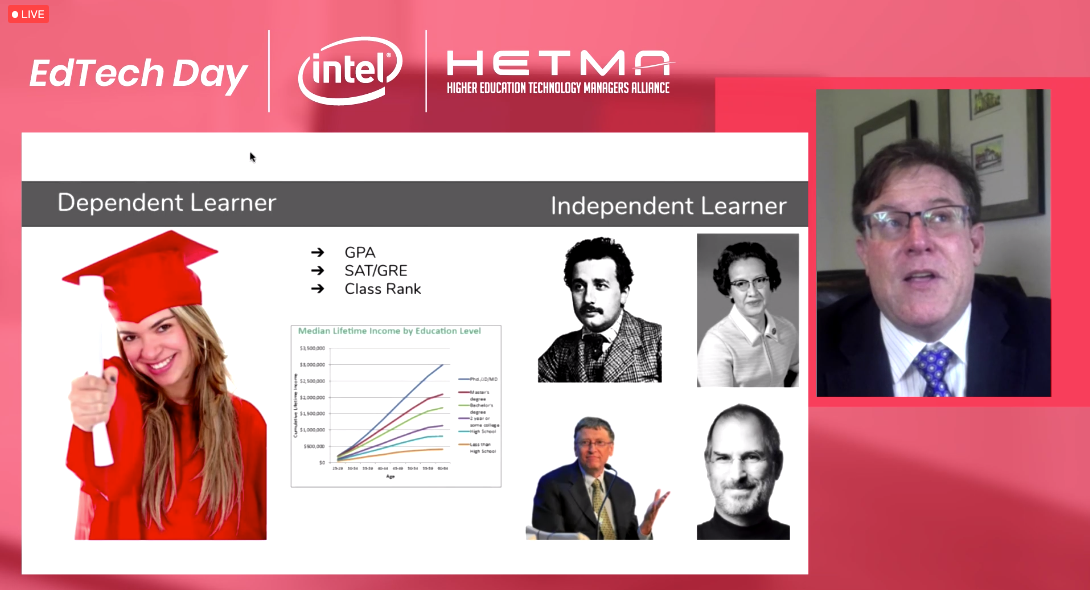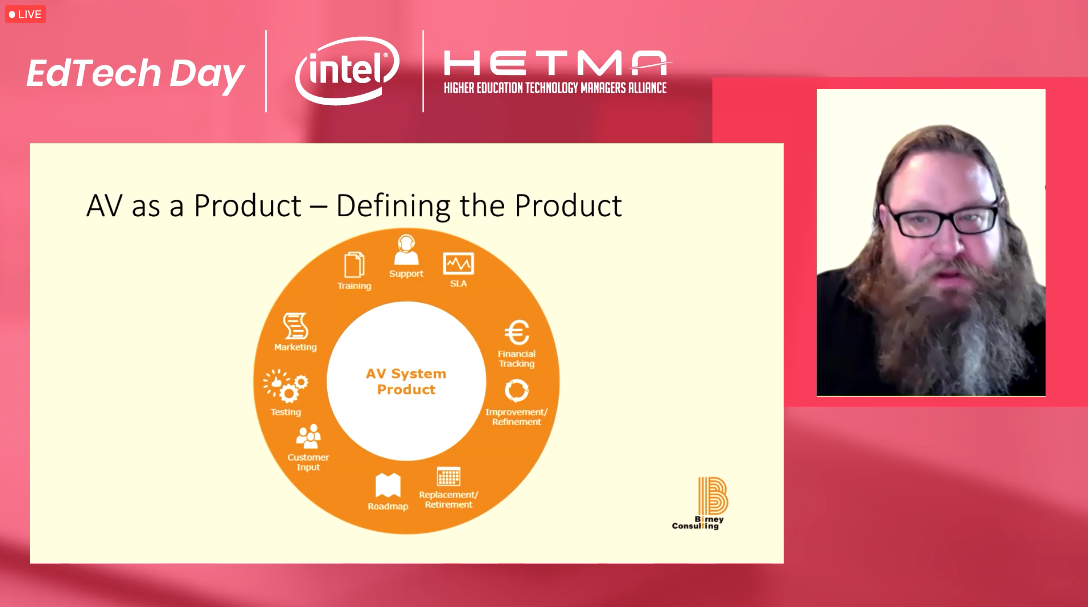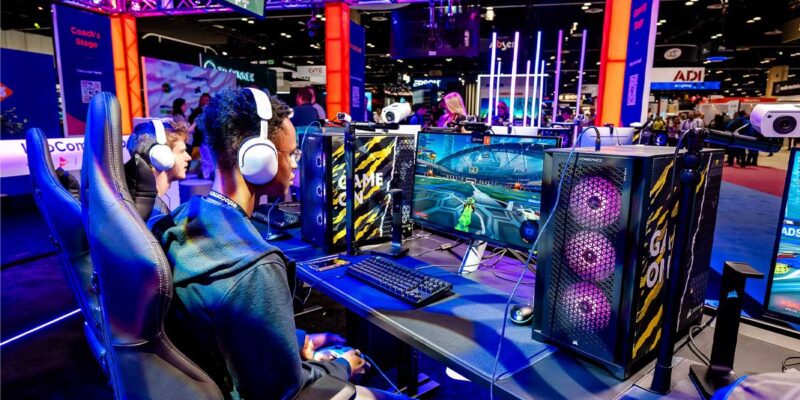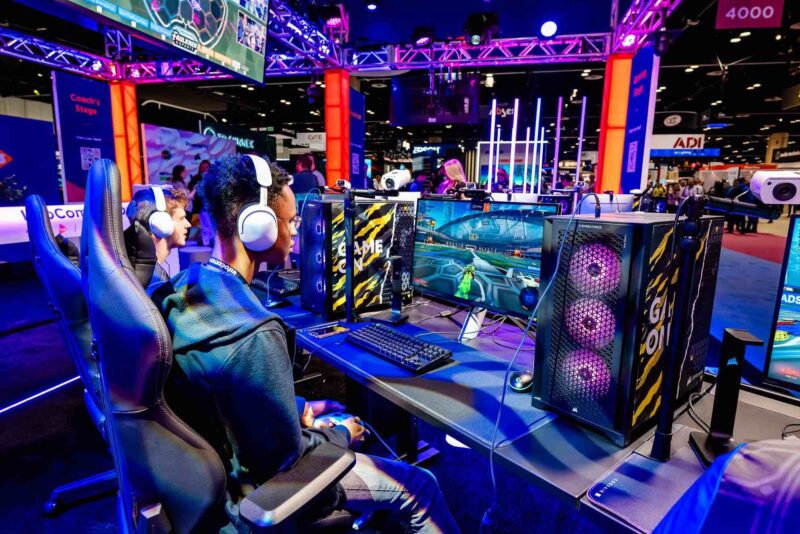EdTech Day of LAVNCH WEEK 2.0: Hybrid, HyFlex and Where EdTech Is Headed

LAVNCH WEEK 2.0 is moving right along, everybody.
Thursday’s theme was EdTech Day — possible thanks to all the support from Intel, Nureva, NEC Display and our partner for the day: HETMA (Higher Education Technology Managers Alliance).
Read on for our recap of the day.
Keynote: Reimagining the Classroom
It’s hard to reimagine what the classroom will look like in the future because everyone — every school, every firm, every think house — seems to be approaching it a little differently. But the data doesn’t lie: Any (and all) change has been accelerated by COVID-19. James Ashby, president of Edify Education Services, joined us Thursday to explore the education trends made possible by emerging technologies. In his keynote, “Reimagining the Classroom,” we learned about a different perspective on shifts in education, a perspective from the research side. James’s data offered a fresh look at the changes from someone who doesn’t live and breathe AV. Thus, I appreciated the new angle to the questions we’ve been asking and asking and asking: how will the classroom environment change?
The current education environment has been questioned time and time again regarding how teachers teach, how students learn and who has the power and control. Take away much of the technology (like personal laptops and multiple displays) and how different, really, is the structure/setup between older classrooms and today’s classrooms? We have new technology, but through the same classroom arrangement (lecturer at the front; students in rows) you could argue we’re still fostering what James explained as the “dependent student.” How should we start reconsidering new positioning and setups in classrooms to be more like collaboration rooms? Are we even thinking about those things yet? James said yes. In fact, I know the answer is yes because we have a room at Carolina that isn’t set up in the traditional style. But this example — Room 58 at UNC-Chapel Hill’s journalism school — is the exception, not the rule.
So, we were all sent home in March and all started learning through Zoom — even the young kiddos. Did it work? Yes and no.

There have been different reactions by students in these new environments — some have thrived because they have been able to leave the bureaucracy of the educational process and explore learning in different kinds of platforms as opposed to being guided by instructors solely in the classrooms. By contrast, students more dependent on the school system’s processes (lecturing process, grading process) may not like being sequestered from the classroom — their learning processes are dependent on what’s known and familiar.
I like what one of our participants, Kevin, said in the LAVNCH WEEK live chat: “Faculty may need to think and teach differently for students to learn.” Kevin is right. When students start to come back to the classroom in the fall (in waves, mind you), a new hybrid/HyFlex classroom space will need to support each student equally, whether remote or in the classroom. It needs to work for instructors too, who will also need to work collaboratively with their programs to figure out a method of teaching that’s not just teaching talking to the screen.
The trends that James discussed weren’t created because of COVID-19, but he’s seeing potential for big mindset shifts in leadership in both K-12 and in higher ed. That mindset shift is not so much an innovative, new thought to address educational needs of students but, rather, a mindset that leadership has become more relaxed in their fears of taking risks with technology. And, no, online education is not new and is not considered a risk in itself. (It’s been developing in K-12 and higher ed for many, many years.) But those developments haven’t been fully embraced at traditional universities or K-12 as an enterprise itself, so there’s still room to grow. The thing COVID-19 has impacted the most in leadership’s minds, James said, is taking more risks — exploring, at a more aggressive pace, different types of learning environments for students than what was offered before.
A “new mindset” by education leaders is a new willingness to experiment more with technology to create educational experiences for students outside the learning process of yesteryear. As technology providers, the data presented here can help us understand the greater context of our roles and how important we are in this space. But you have to be able to show education leaders how your technology promotes a DIFFERENT kind of learning than the one that’s being challenged, fostering different types of learning and not being conformed to the same spaces.
LAVNCH & Learn: Lifecycle Management in EdTech
Our EdTech Day LAVNCH & Learn speaker Thursday was Colin Birney, the principal at Birney Consulting, who, fun fact, is also an adjunct instructor for AVIXA. (He’s also a great guitarist, we hear.) I love Colin’s LinkedIn mantra: “When we partner together, you don’t just get a wealth of experience that spans many industries and countries, but also someone who understands your job.” That’s because, before becoming a consultant, Colin was us; the person businesses would depend on to keep its AV, UC and IT services not just running but thriving. We spoke to Colin last week and learned Thursday about the new classroom environments we’ll start to see soon. With a wealth of understanding for the challenges of managing service and support (from design/installation and service/support planning to lifecycle planning and project management), Colin was well equipped to tell us all about lifecycle management in EdTech.
Here are four excellent points I learned from Colin’s session Thursday:
AV as a Product. To understand the full lifecycle of management in EdTech, we have to realize that customers hold a lot of weight in the industry, even if they may not know it. AV as a product is, generally, a collection of products or components needed for the customer’s system. Colin argues this needs to be a different approach from what we normally do in AV — get a quote, give them the tech, give them the customer service number to call when there’s a problem. All the steps in the screen shot Colin created below should really be taken before you even sell your first system — it’s the entire life cycle. And it’s not the most glamorous thing, lifecycle standards. He adds, “It’s boring; there’s no jokes.” Colin adds that products really need to be “purpose-built.”

Purpose-built solutions over gear. On the note of “purpose-built,” customers don’t care about specs, Colin adds. Customers care about what the product does for them and how it lets them do their job. We quoted Colin in his pre-LAVNCH interview with Steph Beckett, and we’ll quote him here again now: “A thing that I say fairly often — and again, I think people don’t like to hear it — is that nobody cares about gear. I don’t care what brand your TV is, I don’t care what brand your projector is, I don’t care what your microphone is, customers care about features. What does it do and how do I do it? Does it give me a big enough image for this room? Can I make a phone call? That’s how you sell something — so really the biggest thing is creating a feature set to go with a product …” So, basically, we can nerd out about specs all day but customers don’t really care about nits and brightness. They care about whether the product will do its job.
AV/IT convergence. Colin explains that AV, traditionally, has been “set and forget.” He argues that, in EdTech, we need a more IT-like, with a standardized approach, something many AV integrators might brush off — but really need to hear out. Part of it is making our services as attractive as possible. The reality of the AV/IT convergence is a lot of contracts, a lot of documentation, a lot of decisions supported by data, a lot of “no’s.” But it’s effective and seen with high value to the customer.
Standardization is your friend. Standardization is becoming more necessary in universities and schools as they’re shifting from a full in-person model to more online classes this fall. “The things that standardization brings is the way products work. Something like a phone has a really strict set of rules and engagement between me and the customer. That’s ultimately where we want to be in this industry — I need to be able to respond to SLA requirements and meet them without feeling stressed. When an integrator sees, OK, I have two hours to respond, four hours to get to site, 48 hours of resolution, they start sweating because how am I gonna do that every time?” Colin asked. He added, “Well, you have to set the mechanism in place to set up how the system works. Standardization allows you to be more agile because you can create a really strict set of rules for engagement between you and your customer because you understand.”

Did I miss any of Colin’s key takeaways? Which would you add?
Panel: A Discussion on How UCC Tech Can Totally Solve HyFlex & Hybrid Classrooms
EdTech Day ended strong on Thursday, with a killer panel full of the brightest minds in this space.
I’ll give you one point from each speaker that I found great. If you want the full context of these quotes and the panel, register to watch the full session by getting your LAVNCH WEEK 2.0 credentials.

Gary Kayye, Director & Co-Founder – THE rAVe Agency
Gary Kayye, our moderator for the panel, argued that what could be missed in this first phase is collaborating on the actual curriculum — having professors with different perspectives and approaches that we can work with NOW, not later. He added that the best we can do for classrooms this summer is to ensure connectivity, adding cameras, etc. But “the curriculum wasn’t set up to be able to be managed this way,” Gary added.
Craig Park, Principal Consultant, Sextant Group / NV5 Engineering & Technology
If all this had happened 10 years ago, we wouldn’t have had AV-over-IP and other collaboration technology like Intel Unite that have seen us through, Craig Park pointed out. “There were campuses that were well-positioned to flip to online quickly; other, smaller ones struggled, as they didn’t have the online component,” Craig said. His advice for parents of K-12, a group struggling a bit harder with all this as they’ve had to suddenly relearn calculus as at-home teachers: look up best practices for home-based learning. Though Craig would hope districts are recognizing the challenges and providing guidelines too.
Sharon Crawford, Studio Principal of Workplace Interior Architecture at Little Diversified Architectural Consulting
Gary asked Sharon Crawford how she’d re-engineer everything if all this were to happen again. Sharon added that, in K-12, you’ll start to see smaller tables and groupings — almost poised like furniture — used as multifunctional spaces, etc.
Brooke Hay, Assistant Vice President, Facilities Planning and Capital Programs, University of Nebraska
“Some campuses did a much better job adjusting than others,” Brooke Hay of the University of Nebraska pointed out. Brooke added that a longer winter break could be really great for universities who want to do shorter, pilot pop-up opportunities to test out technology and next steps.
Brian Cockrell, Co-founder/Product Owner – Intel Unite
“All of us can’t have an AV director there for every classroom,” Brian Cockrell pointed out. We need a flexible solution with hardware and software integrated, one that’s flexible enough with the compute power.” Brian added that different classrooms will have different needs depending on the subject matter — whether it’s science or math or music.
‘Til Next Time
Favorite session? For me, it had to be the panel. But I also REALLY enjoyed hearing Colin speak, and James’s insights were really incredible.
I hope you enjoyed this wrap-up. You can check out all our LAVNCH WEEK 2.0 coverage — like these summaries and all the product videos/feature videos from our supporters — here. Then catch the next LAVNCH WEEK 2.0 story:
Digital Signage Day of LAVNCH WEEK 2.0: ‘Gotchas,’ Watch-outs and Getting Safely Through the Doors





